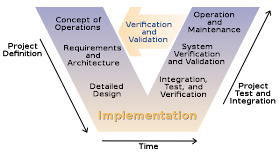Here in my hometown, they've discovered lean principles applied to construction:
The SkyHouse high-rise will top out in just a few weeks at 23 floors. If it stays on track, the building's 320 units will open ... only 13 months after the first dirt was shoveled aside. It takes that long just to build some custom homes.
The tower's builder, Batson-Cook Co., isn't pushing workers to rush; the job has gone quickly because of something called the "Lean" method, which is dedicated to ridding the construction process of waste, especially wasted time. Work schedules have been drawn so that nobody is left waiting on someone else
As the newspaper quote says, this project is going along in remarkably short time; and, the cost is reasonably under control.
And so what is the "lean method" applied to hi-rise construction? In this case the project manager adopted a unique schedule sequence for both task and resource.
The way we've always done it
The usual approach is to schedule each floor in a trade-craft driven sequence: first all the steel workers come in; then all the cement guys; followed by the plumbing and electrical, glass workers, and the like.
Another way to do it
In general, what they did was build each floor with parallel time boxes that align with different physical spaces, each time box/space centered on a particular trade. So, while the cement guys were working in one space on a floor in one time box, the electrical or plumbing guys were working on the same floor but in a different space in the same time box.
As one block was finished, the tradesmen (mostly men, but some ladies) rotated to the next block, and then up to the next floor. This makes for somewhat of a spiral planning method
The idea is that no trade is idled waiting for another. Each is fully engaged, so there's little loss to marching army expenses. The newspaper didn't say whether some Kanban system was incorporated for parts and supplies, but the supply chain had to be adjusted.... lot's of small lot deliveries. That may have driven the cost a bit, depending on how deals were struck.
Maybe
Bent Flyvbjerg should come to town, take in the theme parks (no small feat of engineering, given the swamps they started with), and then see how downtown is done also
Check out these books in the library at
Square Peg Consulting









